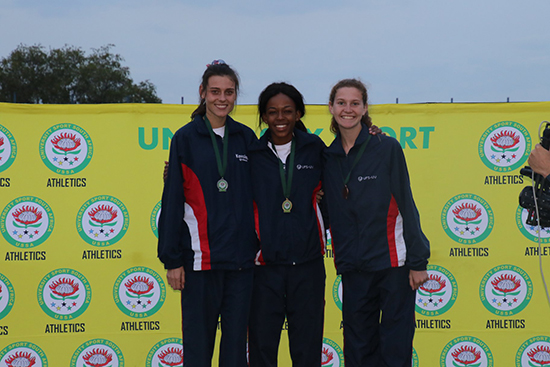Latest News Archive
Please select Category, Year, and then Month to display items
04 May 2018
Photo Facebook
 From left: Marné Mentz (second), Ts’epang Sello (first) and Tyler Beling (third) were in a class of their own, taking the first three spots in the 1 500m at the University Sport South Africa national championship in Sasolburg.
From left: Marné Mentz (second), Ts’epang Sello (first) and Tyler Beling (third) were in a class of their own, taking the first three spots in the 1 500m at the University Sport South Africa national championship in Sasolburg.
As expected, the Kovsie athletics team made the University Sport South Africa (USSA) national championship, held over the weekend in Sasolburg, one to remember.
Eight athletes earned gold medals, which is twice as many as last year. The total of 24 medals (including seven silver and nine bronze) is also double the number won in 2017.
They ended third, just one gold medal below the University of Johannesburg. The female athletes won the women’s competition and contributed to seven of the eight gold medals. The Kovsies dominated the 1 500m and 5 000m events in which they both claimed the first, second and third spots. They even grabbed the fourth and sixth position in the 5 000m in which Kesa Molotsane triumphed, with Tyler Beling second, and Marné Mentz third. Mentz and Beling swapped places in the 1 500m behind Ts’epang Sello.
Molotsane also won the 10 000m in a record time of 34:49.16 which is a massive three minutes and five seconds quicker than the previous record.
The 800m title also now belongs to Sello. She and Beling won a third medal (bronze) as members of the 4 x 400m relay women’s team.
The other gold medalist was Lara Orrock (3 000m steeplechase), Lynique Beneke (long jump), Esli Lamley (pole vault) and Rynardt van Rensburg (800m).
All five Kovsies who competed at the CAA Southern Region Youth & Junior Championships that took place over the weekend in Boksburg, won medals. They were Pakiso Mthembu (gold, 5 000m), Michaéla Wright (gold, long jump), Tyler (gold, 1 500m), Tsebo Matsoso (silver, 200m) and Orrock (silver, 3 000m steeplechase).
Expert in Africa Studies debunks African middle class myth
2016-05-10

From left: Prof Heidi Hudson, Director of the Centre for Africa Studies (CAS), Joe Besigye from the Institute of Reconciliation and Social Justice, and Prof Henning Melber, Extraordinary Professor at the CAS and guest lecturer for the day.
Photo: Valentino Ndaba
|
Until recently, think tanks from North America, the African Development Bank, United Nations Development Plan, and global economists have defined the African middle class based purely on monetary arithmetic. One of the claims made in the past is that anyone with a consumption power of $2 per day constitutes the middle class. Following this, if poverty is defined as monetary income below $1.5 a day, it means that it takes just half a dollar to reach the threshold considered as African middle class.
Prof Henning Melber highlighted the disparities in the notion of a growing African middle class in a guest lecture titled A critical anatomy of the African middle class(es), hosted by our Centre for Africa Studies (CAS) at the University of the Free State on 4 May 2016. He is an Extraordinary Professor at the Centre, as well as Senior Adviser and Director Emeritus of the Dag Hammarskjöld Foundation in Sweden.
Prof Melber argued that it is misleading to consider only income when identifying the middle class. In his opinion, such views were advanced by promoters of the global neo-liberal project. “My suspicion is that those who promote the middle class discourse in that way, based on such a low threshold, were desperate to look for the success story that testifies to Africa rising.”
Another pitfall of such a middle-class analysis is its ahistorical contextualisation. This economically-reduced notion of the class is a sheer distortion. Prof Melber advised analysts to take cognisance of factors, such as consumption patterns, lifestyle, and political affiliation, amongst others.
In his second lecture for the day, Prof Melber dealt withthe topic of: Namibia since independence: the limits to Liberation, painting the historical backdrop against which the country’s current government is consolidating its political hegemony. He highlighted examples of the limited transformation that has been achieved since Namibia’s independence in 1990.